Bouncing back from rock bottom
The untold story of how DC fought back against the 2023 crime surge
Pretty much everyone in DC knows that crime got worse last year. Homicide rose 35% compared to 2022, overall violent crime was up 39% and property crime increased 24%. But many people don’t follow the month-to-month crime trends. Newly released MPD data helps show the ways that DC has fought back and seen significant decreases in crime rates since the Summer 2023 peak. The dramatic crime spike and then decrease was far beyond normal levels of seasonality and corresponds with important, underreported operational changes in DC’s criminal justice system. We entered 2023 with some of the lowest arrest and prosecution rates in modern DC history and over the course of 2023 we got a real experiment in what happens when a city steps up enforcement. Learning from and building upon that progress is critical for those of us who want to see continued decreases in crime rates.
Prelude: Complacency before the crime surge
It may be hard to believe but at the end of 2022 the official overall crime trends were actually positive. Both violent crime and property crime were at record lows:
While homicides, carjackings and motor vehicle theft were higher in 2022 than the pre-COVID baseline; large decreases in other crimes meant that overall reported crime numbers were down. There was even some optimism about homicides since they had fallen by 10% from 2021 to 2022. Deputy Mayor for Public Safety and Justice Lindsey Appiah reflected this background during a 2023 exchange on Twitter:
Whatever concerns the public had about crime had not inflicted much of a political cost on Mayor Bowser. She had recently won renomination (and hence reelection in heavily Democratic DC) with 49% of the vote against a divided field. She’d racked up landslide margins in DC’s wealthiest neighborhoods; 81% of the vote in the precinct around Spring Valley, 76% in Wesley Heights, 73% in the Palisades and so on. Her 5,300 vote margin (over challenger CM Robert White) from wealthy Ward 3 was larger than her vote margin in wards 5, 7 and 8 combined. The stark differences between these parts of DC are illustrated by the fact that in 2022 the Mayor’s Ward 3 stronghold had two homicides while wards 5, 7 and 8 had 156 (or 77% of DC’s total) homicides. Voter dissatisfaction with crime had been no barrier to Mayor Bowser’s reelection and if anything it was a winning issue for her. As a result there was almost no political incentive to proactively tackle the breakdown in enforcement across DC’s criminal justice system before 2023’s disastrous crime surge.
The first key parts of enforcement that had frayed by the end of 2022 were the Metropolitan Police Department’s (MPD) clearance and arrest rates. Homicide clearance rates had fallen to 62%, the lowest level since 2015. Overall arrests had also fallen significantly; driven partially by a decrease in the number of officers but primarily by a ~44% drop in arrests-per-officer that began during COVID and never recovered. Note that the time scale is different in the graphs due to differences in data availability:
Research from other cities shows that when police cut back on the number of arrests they prioritize higher quality or more serious arrests. Therefore one would expect that this massive reduction in the number of MPD’s arrests would cause prosecutors to file charges in a higher percent of the smaller (but presumably higher-quality/priority) pool of arrests. However in DC most adult prosecutions are handled by the unelected United States Attorney’s Office (USAO) and during these same years they began pressing charges in fewer and fewer of MPD’s arrests. Mayor Bowser and some members of the Council had been repeatedly warned that “a high percentage of arrests are never prosecuted” in the annual NEAR Act Felony Report but according to the DC Auditor “the reports are not widely used; one senior official involved in criminal justice policy stated that she had not looked at the reports.” And so every year the USAO declined to prosecute more cases and no one in DC government seems to have done anything about it:
One critical contributing factor was that DC’s crime lab lost its accreditation in April 2021. Over the next 2 years neither the Bowser administration nor USAO secured sufficient outside evidence testing capacity to keep investigations and prosecutions rolling. This specifically harmed investigations into DC’s drug trade, which is a key driver of gun violence. The combined effect of vastly fewer arrests AND the USAO pressing charges in a smaller percent of arrests meant that prosecution volumes in DC collapsed and hit record lows in Fiscal Year 2022:
The decrease in prosecution wasn’t limited to just the shrinking volume of new cases. With the courts barely functioning (due to COVID-era restrictions and judicial vacancies) the USAO dramatically increased the volume of already charged (or “papered”) cases that they dropped. In 2022 alone they dropped 282 felony cases and over 1,000 misdemeanor cases and that was actually an improvement over 2021:
Because of the huge decrease in prosecutions the detainee population at the DC jail was approaching record lows and would hit its lowest census in recent history in March 2023:
The jail census decreased despite the fact that DC judges were actually becoming more likely to detain a defendant pretrial; showing that the primary driver of the decreased jail census was the decrease in prosecutions:
Similarly the population of people incarcerated in Federal prison for DC felonies fell to record lows. The vastly reduced number of prosecutions and the USAO’s shift towards more generous plea bargains meant that fewer and fewer convicted felons were being sent to prison (“Admissions” in the graph below). With the outflow (“release”) of people completing their sentences outpacing the number of admissions the incarcerated population fell by more than half since 2010:
Collectively this breakdown in arrests, prosecutions and sentencing meant that at the start of 2023 DC was uniquely vulnerable to a crime spike:
The certainty of punishment in DC was weaker than it had been in decades. More people than ever had firsthand experience getting away with crimes; either by evading arrest or benefitting from prosecutors failing to convict them. Many more had seen their peers get away with crimes. Since the certainty of punishment is by far the strongest deterrent against committing crimes, the failures of the Bowser administration and multiple US Attorneys (culminating in current USA Matthew Graves) undermined the certainty of punishment in DC and left the District incredibly vulnerable.
Fewer people than ever were “incapacitated” from committing more crimes by being detained in jail or prison. Despite a rhetorical focus by Mayor Bowser and USA Graves on the importance of incapacitating criminals; they had focused most of their energy on this issue opposing small-bore “reform” efforts to shorten sentences. This missed the fact that the largest driver of less incarceration in DC was reduced prosecutions and more generous plea bargains by the USAO.
Alongside other social ills the population of disconnected young people was larger than ever. Absenteeism had been getting worse in DC schools before COVID and skyrocketed during the pandemic. 70% of high-schoolers were chronically absent in school year 2021-2022 but DC’s social safety net and Court Social Services largely failed to do anything to get these kids back on track. These thousands of disconnected kids were at much higher risk of falling into criminal activity
The 2023 Crime Spike
The graph below helps illustrate just how violent Summer 2023 was for Washingtonians. Violent crime in 2023 (Orange line in the graph) was actually running lower than 2022’s already record-low violent crime rate through mid-February before rising in April and then exploding in June and July:
Property crime had a less dramatic rise-and-fall but peaked in August before coming down towards the end of the year:
One of the most compelling hypotheses for why crime spiked when it did relies on the interconnection between motor vehicle theft and robbery/carjacking:
Motor Vehicle Theft had gotten more common during COVID and the infamous “Kia Challenge” video first started circulating in July 2022. Kids (and some adults) in cities across America began using the vulnerabilities of many Kia and Hyundai vehicles to begin stealing cars en masse in October 2022.
MPD officers and journalists have documented extensively how stealing cars got normalized for many kids; some of whom just started by riding along in stolen (“free”) cars with their friends and then moved on to stealing cars themselves. The fact that so few of them were ever arrested and prosecuted for stealing cars helped undermine whatever deterrence there might have been. As Washington Post columnist Megan McArdle put it: “I think we've underestimated the extent to which information about the ease of committing various crimes can go undiscovered for a surprisingly long time, and then suddenly cascade through the system.”
More violent criminals (adults and juveniles) realized that they could easily use stolen cars to move around undetected, escape from robberies and even use them to facilitate carjackings of other vehicles. In the graph below the dataset includes most carjackings in the “robberies” category and one can clearly see that motor vehicle thefts spiked first followed by a spike in robberies:
MPD’s Response
By April both property crime and violent crime were significantly higher than the previous year but there was no visible uptick in MPD arrest rates. Former Chief Contee announced in May both his retirement AND a new policing strategy but unsurprisingly there doesn’t seem to have been much change until his permanent replacement Chief Pamela Smith took the helm in July 2023:
From January-June 2023 MPD averaged 0.43 arrests per officer per month; in line with the post-COVID equilibrium despite much higher crime rates.
From August-December 2023 (after Chief Smith’s appointment) MPD averaged 0.49 arrests per officer per month, a 14% increase. Notably this 5 month period seemed to indicate a new equilibrium after MPD had been stuck at ~0.40 arrests per officer per month ever since COVID.
The large surge in arrests in July and August 2023 (with August setting a post-COVID record high of 0.54 arrests per officer) was possibly critical in taming DC’s summer crime spike. In July and August we saw the following changes:
Adult arrests rose 8% compared to May-June
Juvenile arrests rose 24% compared to May-June
Robberies fell 43% from a peak of 479 in July to 328 in August down to 274 in September
Carjackings fell 44% from a peak of 140 in June and 128 in July to 88 in August and 79 in September
This steep increase in arrest volumes happened without any sudden increase in MPD personnel or repeal of police reform. Instead it appears that Chief Smith took on the “toxic leadership” of MPD management aka “the white shirts.” As one MPD officer put it:
“Chief Smith scared the shit out of the white shirts.” “So now, instead of white shirts telling people to only answer the radio, they are saying if you see something, do something.”
Recall that many rank and file police officers have previously alleged that MPD management has told them to be passive, to just be “sitting in their cars, sitting on the corner, and just telling citizens that they’re around. That’s the message that’s received and that message is carried through the command staff all the way down to police officers.” Less charitably, we’ve also heard police officers allege that their coworkers are more than happy to avoid actual policing: “Most of your coworkers, though, will be happy to let you do the lion's share of the work while they hide in a parking lot.” This was the dysfunctional situation that Chief Smith inherited and it’s to her great credit that she seems to have shaken things up at MPD. Former Assistant Chief Kane described Chief Smith’s work like this:
“The Chief alluded to what occurred in 2020 that really shifted how our officers kind of [unintelligible] up. And so getting them back in the game that has really been a big push from the Chief right down to the the executive command staff and to the management that we have on the street. And so at this point what we’re really doing is rebuilding their confidence back up, right? They were beat down just a little bit. So we’re rebuilding their confidence back up, and the more they see that they’re supported, the more they see that we’re out there with them, the more work that they’re gonna do.”
Regular readers may recognize these quotes but they’re worth bringing back precisely because we now have the data to confirm that there was a real change happening at MPD under Chief Smith. The unprecedented surge in arrests in August also corresponds with reporting in the Washington Post about Chief Smith pushing the MPD command staff at the same time:
In addition to pushing MPD to be more proactive (which seems to correlate with more arrests) there’s also been some recovery in MPD’s clearance rates after a disastrous drop initially in 2023:
MPD released clearance rates for the first 9 months of 2023 which showed massive decreases (i.e. worse performance) in homicides, assault with a dangerous weapon and robberies compared to 2022. This in some respects shows MPD failing to “keep up” with the increased number of violent crimes detectives were being asked to solve.
In July 2023 one of Chief Smith’s first leadership changes was to replace the leadership at MPD’s Investigative Services Bureau (ISB). She moved the then ISB Assistant Chief Leslie Parsons to the Homeland Security Bureau and replaced him with former 4D Commander Carlos Heraud.
When comparing the full year 2023 data to the Q1-Q3 2023 data it looks like MPD has made significant improvements in the homicide and ADW clearance rates towards the end of 2023. However on a year-over-year basis clearances rates are still down compared to 2022 (except for Sex Abuse cases).
Chief Smith deserves a lot of credit for shaking things up at MPD in a seemingly constructive way and there’s still work to do. But Washingtonians should be asking why her predecessors, Deputy Mayor Appiah and Mayor Bowser allowed these problems at MPD to fester for so long before Chief Smith’s appointment.
The USAO’s Response
We still have to infer how the USAO responded to DC’s crime spike in 2023 because they refuse to be transparent with their prosecution data. In March 2023 the USAO came under unprecedent media and Congressional scrutiny when this Substack first revealed (and then many people and media outlets amplified) that the USAO had declined to prosecute 2/3 of MPD’s arrests. The immediate response of the USAO was to blame the District’s crime lab and MPD:
We don’t know if prosecutor behavior changed after the initial media stories because the USAO has only ever released aggregated prosecution counts (not even rates) for January-May 2023. So we’re able to see that January-May 2023 had slightly higher prosecution volumes than Fiscal Year (FY) 2022 but it’s unclear if that represents an increase after they got a wave of unwanted publicity in March 2023.
However, now that we have MPD’s adult arrest data we can track the ratio of USAO prosecutions and adult arrests to see how prosecutors changed their behavior in 2023:
During those same months there were 4,088 adult arrests by MPD and 2,197 new cases charged by the USAO; for a ratio of 0.537 prosecutions per arrest. So while the USAO prosecution rate is a slightly different calculation, this ratio of new cases per Adult MPD arrest is an extremely close proxy measure for the prosecution rate. This is one reason that DC policymakers should mandate the monthly release of MPD arrest data (at least volumes) so that the public can have some estimate of the USAO prosecution and declination rate.
From June-August of 2023 we see that the USAO was at a new equilibrium of ~0.48 prosecutions per adult arrest; which we can estimate is a ~48-49% prosecution rate. This is still a huge outlier compared to other American prosecutors but it does reflect that the USAO did increase the prosecution rate after being scolded by Congress in mid-May 2023. Compared to the 0.40 January-May prosecution ratio this represents a 20% increase in prosecutions (when using the USAO’s preferred “% of a %” approach).
The massive anomaly in this data is in September. The prosecution ratio shoots up from 0.50 in August to 0.67 in September before immediate dropping back down to 0.49 in October. Excluding September, the average month-to-month change in the prosecution ratio is plus or minus 0.06; in other words pretty steady. The sudden spike in September and then collapse in October are changes 3X as large as the normal month-to-month variation. That would be suspicious enough but September also happens to be the last month of fiscal year 2023. The USAO’s end of FY 2023 press conference in October 2023 leaned heavily on an increased prosecution rate in the last quarter of FY 2023 (i.e. July-September) to spin a positive story of improvement. This data strongly suggests that they only temporarily boosted the prosecution rate in order to have “better looking” data for the media and then immediately resumed their previous practices.
Since September the prosecution ratio averaged 0.52 which represents a ~30% increase over the 0.40 level in January-May.
One key part of this story is that there was something incredibly suspicious going on with the USAO in September 2023. None of their stated reasons for improving prosecution rates (more evidence testing, better collaboration with MPD) would plausibly be in effect for only a single month. One possible interpretation is that perhaps ~67% of MPD’s arrests are actually viable for prosecution but the USAO is only choosing to prosecute all of the viable cases when they have a political/media reason to do so. We saw a similar dynamic in June 2023 when the USAO was suddenly able to achieve much higher (and comparable to other American cities) prosecution rates when they wanted to show off success for their Chinatown pilot:
“Graves said he launched a pilot program in June to pursue more low-level, misdemeanor cases stemming from arrests made in and around Chinatown’s Gallery Place Metro station by “turning off any discretion whatsoever” that prosecutors might have exercised previously, as long as there is a viable case.”
The Chinatown pilot and the anomalous September prosecution data suggest that the USAO is declining to prosecute a lot of “viable cases” except when they have a political or media reason to demonstrate results. As frustrating as this dynamic may be for Washingtonians, it does seem like the public pressure has managed to cajole the USAO into prosecuting more cases than the record-low prosecution rate of FY 2022. Even though the USAO’s prosecution rate is still far below other American cities, the relative recovery from 33% to ~52%-53% is still a big difference that is imposing consequences on relatively more defendants. When we factor in that this increased prosecution rate is being applied to an increased volume of arrests we get a multiplicative increase: In January-May they only charged 486 new cases per month while in September-December the USAO charged 714 new cases; a 47% increase. That’s a relatively large shock to the system and a marked increase in enforcement. Notably, this 2023 increase in prosecutor performance seems to be driven by pressure and accountability rather than new resources or legislation. One way that we can see the impact of this increase in prosecution is that the DC jail census has increased significantly:
The DC jail census hit a record low of 1,226 in March 2023
Since then the census has risen to 1,780; an increase of 554 detainees or 45%
Compared to FY 2022, in FY 2023 DC judges were slightly less likely to detain felony suspects so this census increase is primarily due to the increase in prosecution, not any legislative changes in pretrial detention guidelines
One key part of this story that we don’t yet have to data to tell is what happened with juvenile prosecutions over the course of 2023. We’ve only had infrequent data releases from the DC Attorney General and hopefully there will be more transparency in the future. However, given how detention rates logically tend to correlate with prosecution volumes, the rising juvenile detainee census suggests that the increase in juvenile arrests is translating into more juvenile prosecutions:
Hopefully some journalists can help the public’s understanding of this significant shift in enforcement by highlighting more stories from the men and women on the front lines who went through this change and can speak to how it is still unfolding.
It’s an important caveat that these enforcement metrics don’t have a simple linear relationship with crime rates and that all of them are aggregations of individual people, crimes and cases. Arrests without prosecutions don’t have much positive impact on crime; one key fact in 2023 is that arrests and prosecutions rose together. Detention isn’t a good outcome in and of itself, but a proper setting for some higher-risk suspects and sentenced offenders. The fact that DC was at rock bottom on just about every enforcement metric (arrests, prosecution, detention etc.) at the start of 2023 meant that the marginal benefit of increasing enforcement was probably at its greatest. We may not get the same sort of benefit if we “cranked it up” even higher (though we should certainly strive for at least “regular” prosecution rates). But we shouldn’t ignore the lessons of this “experiment” in increased enforcement either.
We saw that a combination of new leadership (MPD) and sustained pressure (USAO) brought about real increases in arrests and prosecutions that correlate strongly with DC bringing down crime rates in the 2nd half of 2023. This post in no way proves to an academic standard that DC’s increase in enforcement is what caused the reduction in crime but the correlation is strong and there’s a clear causal mechanism. Getting MPD “back in the game” and increasing adult prosecutions by ~47% helped raise the certainty of punishment from the rock bottom level we started with in 2023 while the 45% increase in the DC jail population helped incapacitate more would-be repeat offenders. There was probably some role for seasonality in helping tamp down crime, but the steep rise in violent crime in Summer 2023 far outpaced “normal” levels of seasonality in DC. DC is slowly rebuilding the deterrent value of its criminal justice system by addressing the operational rot that made it so vulnerable at the beginning of 2023. Policymakers should build on this progress and put in safeguards to prevent any deterioration like we saw in the past. The hard work of ensuring the effective operation of DC’s enforcement arms isn’t as flashy as new legislation but it is vastly more important.





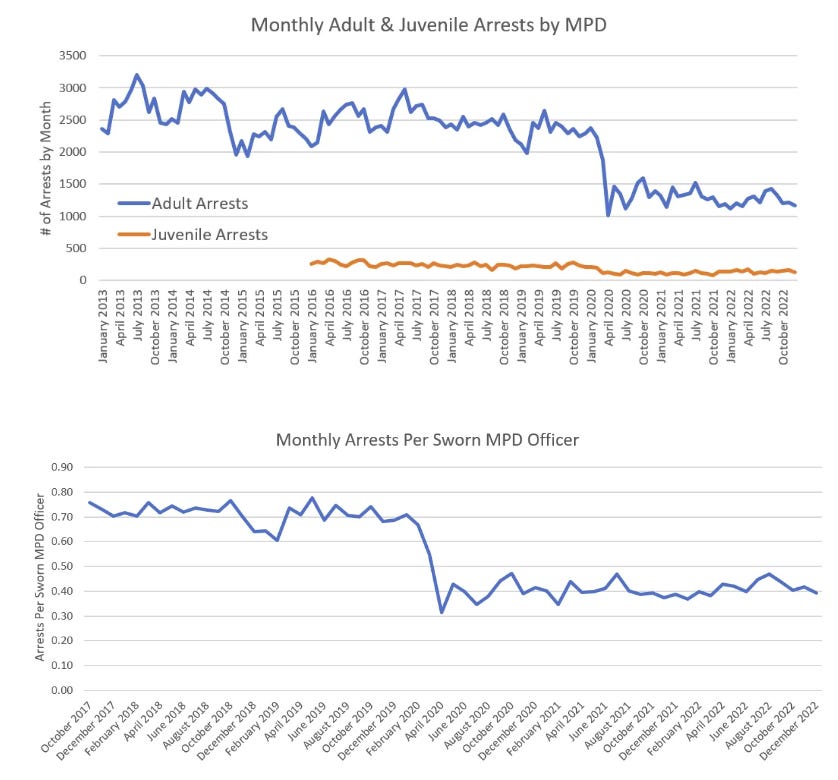
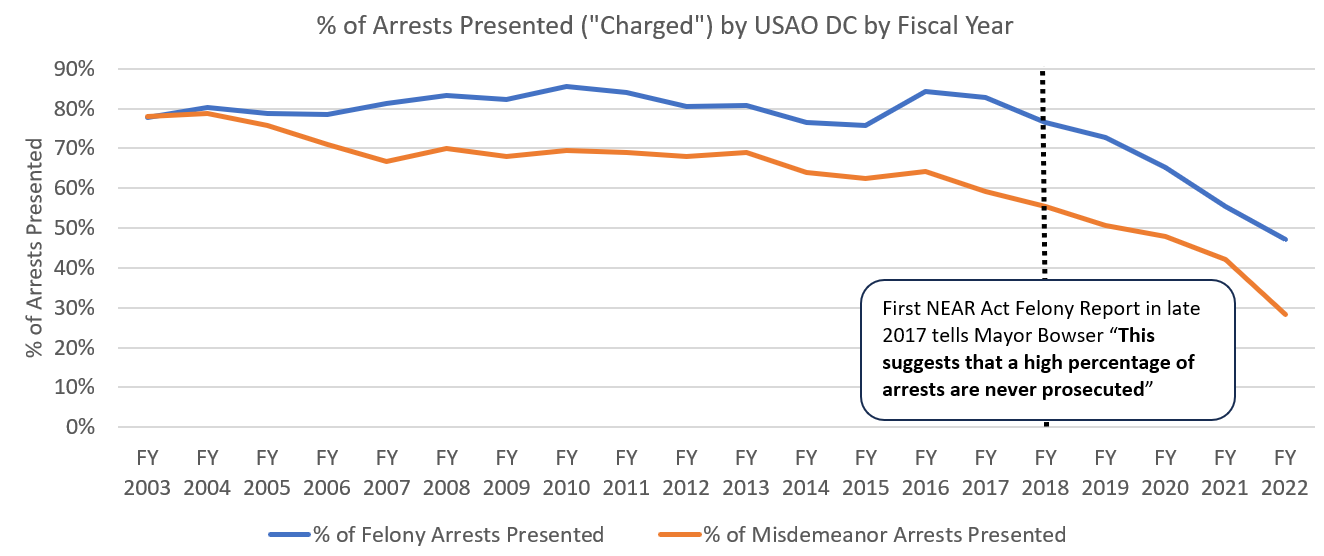

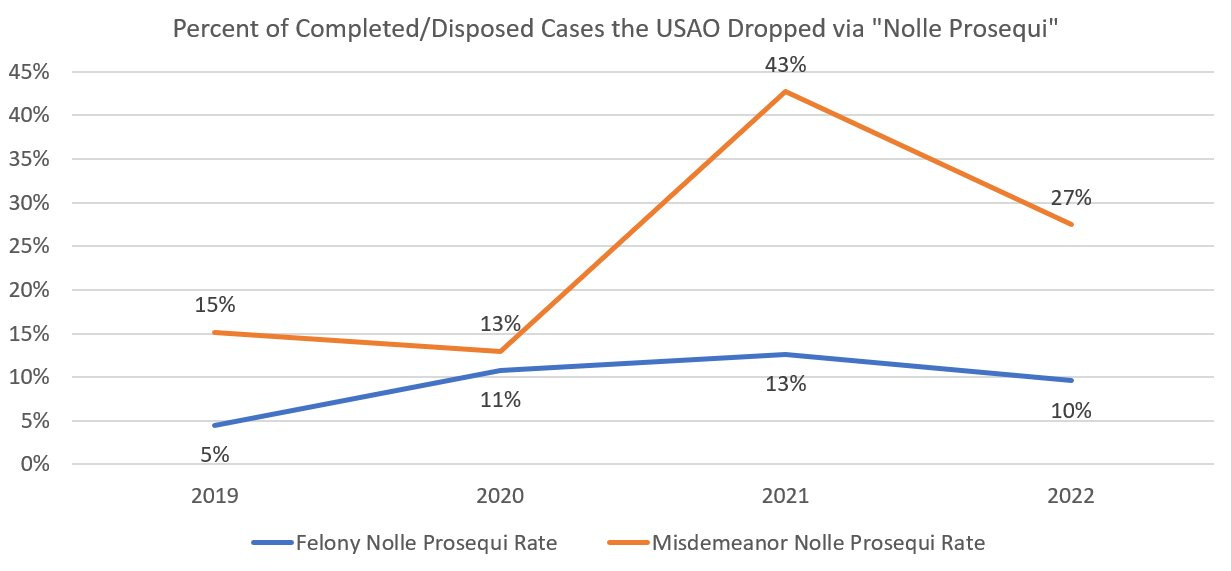




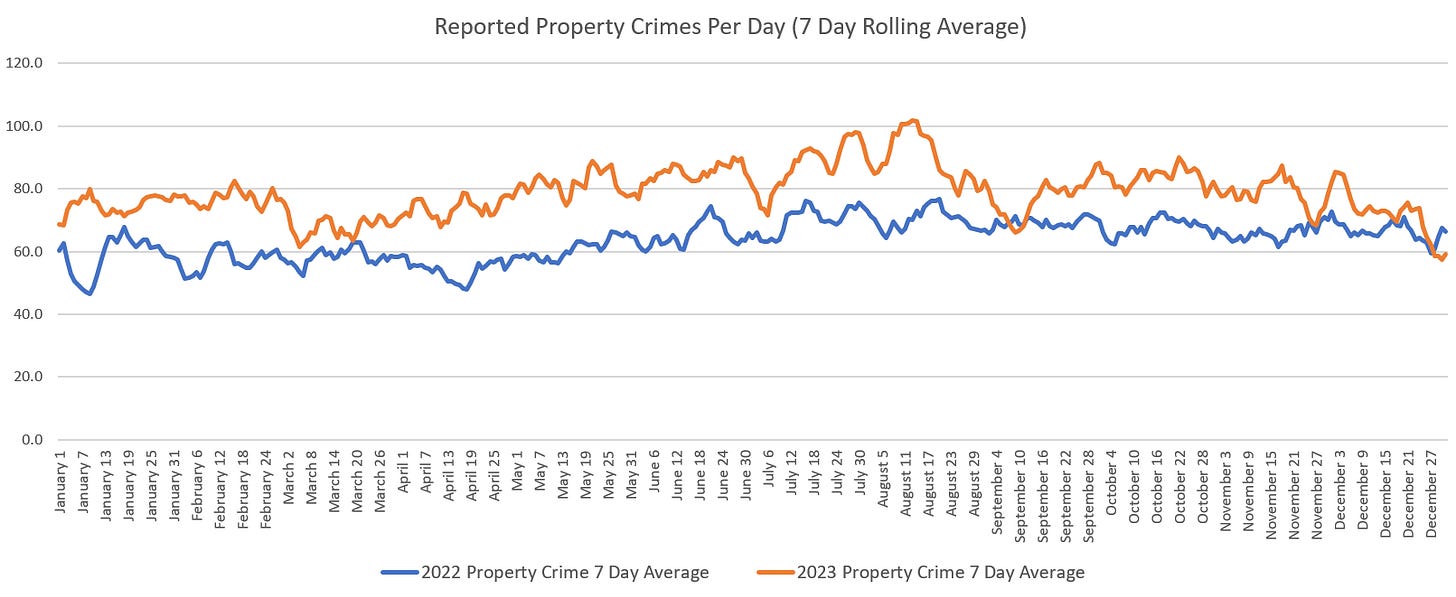



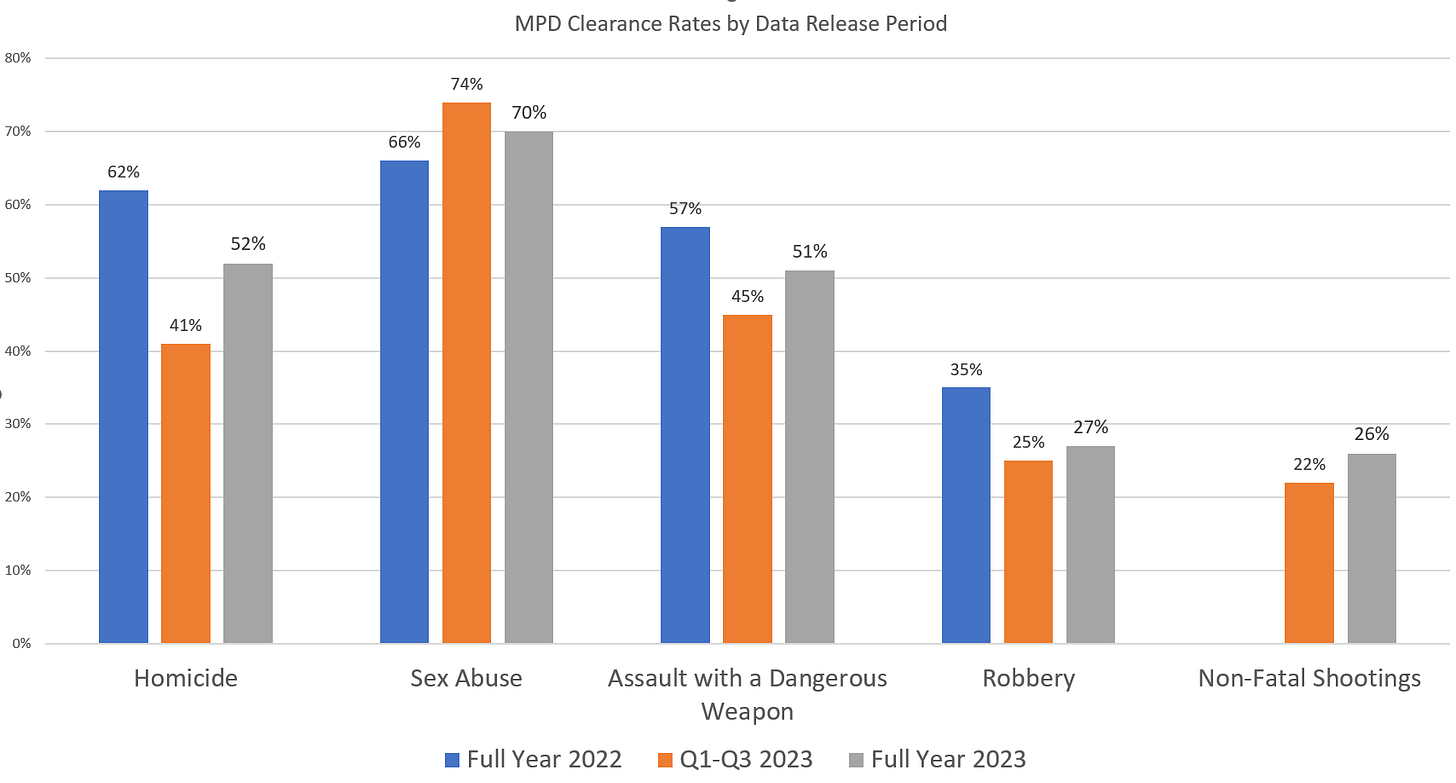
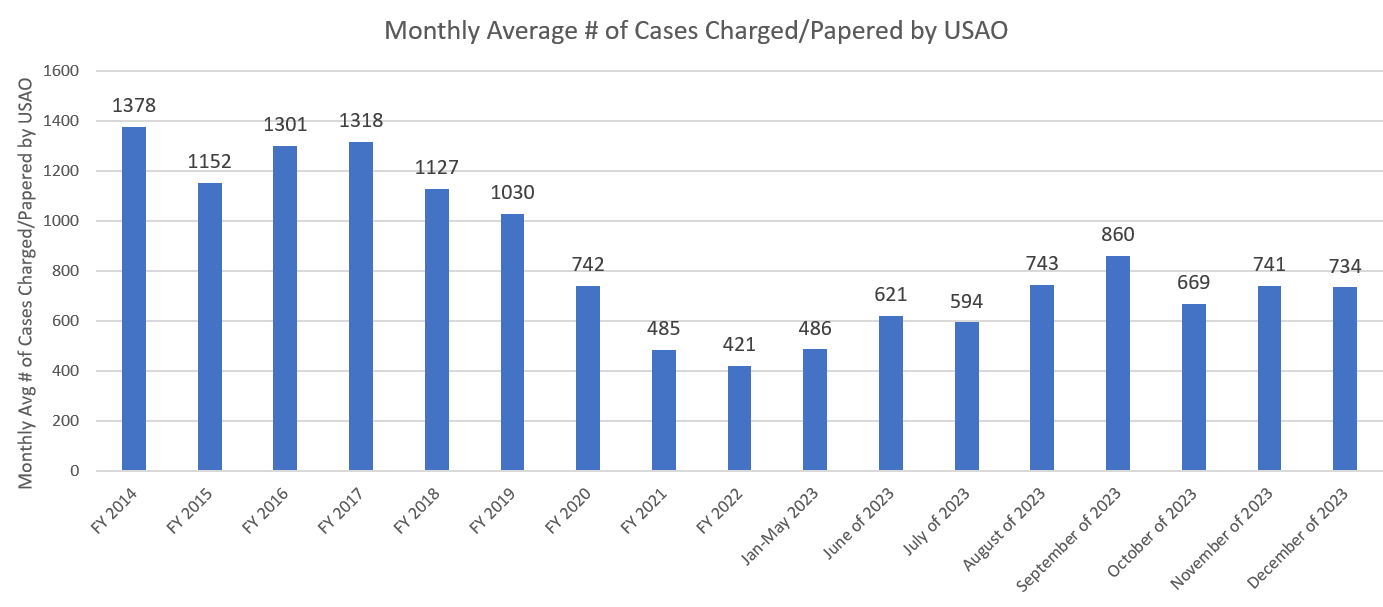
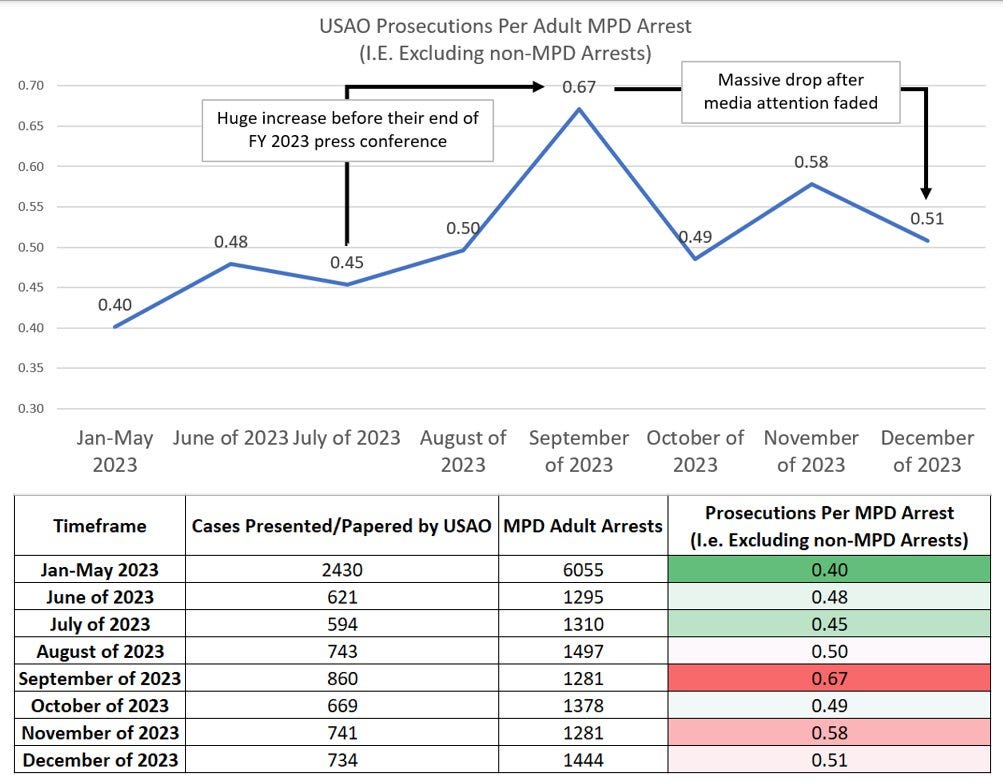
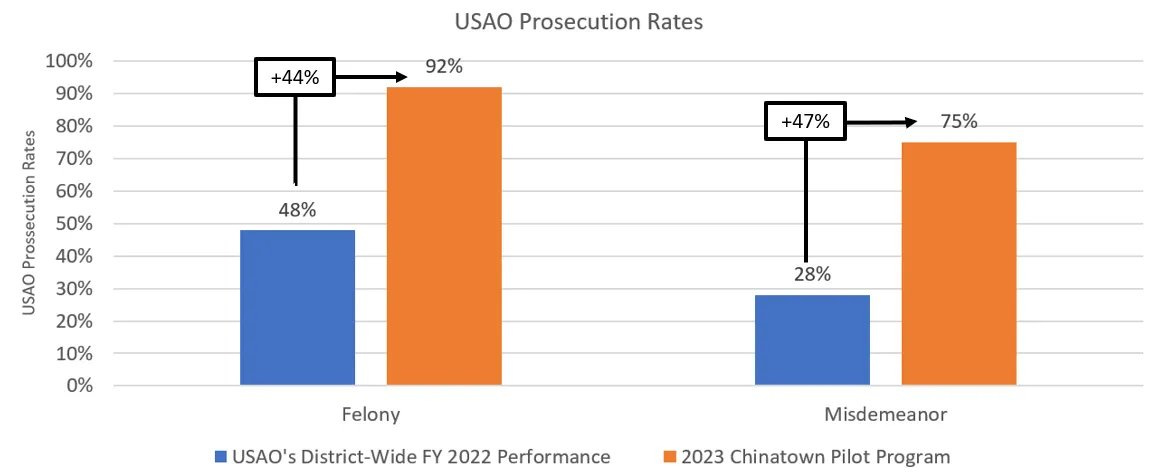


This is EXCELLENT data. Thank you for your work on educating us on the granular nature of these issues. Chief Smith is awesome!
Awesome job. I’ve already voted with my feet and almost never go into the city any longer, but interesting to see the details of what’s going on with my former home of 20 years.
For the big picture and comparisons between cities, the interactive dashboard at the end of this report is interesting to play with.
https://counciloncj.org/year-end-2023-crime-trends/